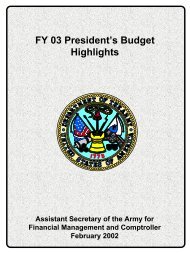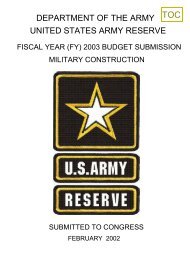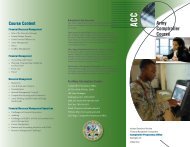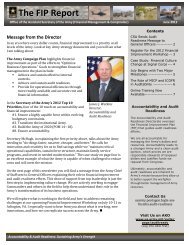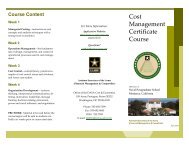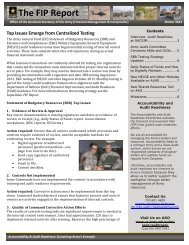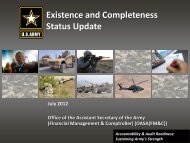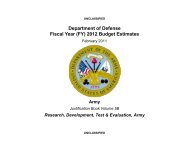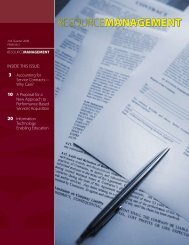Defense Decision Support Course (DDSC) - Office of the
Defense Decision Support Course (DDSC) - Office of the
Defense Decision Support Course (DDSC) - Office of the
- No tags were found...
Create successful ePaper yourself
Turn your PDF publications into a flip-book with our unique Google optimized e-Paper software.
<strong>Decision</strong> <strong>Support</strong> ModelTo positively affect decision making you have to doyour part before <strong>the</strong> decisions are made! You must beinvolved up front—proactive—looking ahead for waysto improve processes or determine <strong>the</strong> best use <strong>of</strong> <strong>the</strong>organization’s resources. This requires you to translate<strong>the</strong> financial aspects <strong>of</strong> decision making into operationalimpacts. With ever diminishing resources you cannotafford to be merely reactive.• Identify <strong>the</strong> Issue• Analyze <strong>the</strong> Issue• Develop Alternatives• Evaluate Alternatives• Make a RecommendationTarget AudienceMilitary:• <strong>Office</strong>r: BC 36 Majors or Higher• Enlisted: Personnel MOS 36Civilian:• Comptroller Civilian Career Program (CP 11)• GS 13 and higher• Students completing <strong>DDSC</strong> receive 27 CPE creditsNomination ProcessSubmit nominations through Command channels to<strong>Office</strong> <strong>of</strong> <strong>the</strong> Assistant Secretary <strong>of</strong> <strong>the</strong> Army (FinancialManagement & Comptroller):• Letter <strong>of</strong> endorsement• Civilians include CP 11 Resume Form• Military include <strong>Office</strong>r Record Brief or Enlisted• Record Brief• SF 181• Individuals are required to use <strong>the</strong> GovernmentTravel Card for TDY expenses.<strong>DDSC</strong><strong>Defense</strong><strong>Decision</strong><strong>Support</strong><strong>Course</strong>For More Information Contact:Comptroller Proponency <strong>Office</strong>ATTN: SAFM-PO Rm. 3E341109 Army PentagonWashington, D.C. 20310-0109DSN 225-7655/COM 703 695-7655Fax Com. 703 614-2832Email: Proponency@hqda.army.milWebsite: http://www.asafm.army.milAKO Page : Comptroller Proponency <strong>Office</strong>DFM&CS: Advancing <strong>Decision</strong> <strong>Support</strong>One Student at a TimeAssistant Secretary <strong>of</strong> <strong>the</strong> Army(Financial Management & Comptroller)Comptroller Proponency <strong>Office</strong>Washington, DCSPRING 2011
<strong>DDSC</strong><strong>Defense</strong> <strong>Decision</strong> <strong>Support</strong><strong>Course</strong>Department <strong>of</strong> <strong>the</strong> ArmyThis course is designed to complement <strong>the</strong> <strong>Decision</strong><strong>Support</strong> instruction embedded in <strong>the</strong> four-week<strong>Defense</strong> Financial Management <strong>Course</strong> also taughtat <strong>the</strong> DFM&CS. The purpose is to acquaint mid– tosenior-level personnel with <strong>the</strong> merits <strong>of</strong> <strong>the</strong> <strong>Decision</strong><strong>Support</strong> instruction so <strong>the</strong>y recognize and more readilyaccept appropriate analysis and recommendations from<strong>the</strong>ir subordinates.<strong>Defense</strong> Financial Management & Comptroller School(DFM&CS) defines <strong>Decision</strong> <strong>Support</strong> as enablingdecision makers to make informed decisions that betterutilize resources and improve mission effectiveness.The school views decision support as a two-phasedprocess providing leaders with viable alternatives,financial and non-financial impacts <strong>of</strong> choosing analternative, and a well-supported recommendation.In phase one, advisors combine data, tools andtechniques to understand <strong>the</strong> environment and analyzehow and why things happened.In phase two, advisors use <strong>the</strong>ir analysis to developand clearly communicate projections, alternatives andimpacts and make recommendations in a concise,actionable, and timely manner to decision makers whomay or may not be subject matter experts.Major topic areasIntroduction to <strong>Decision</strong> <strong>Support</strong>What is it? Why is it important? How does it fit into<strong>the</strong> decision making model? What are <strong>the</strong> benefits andlimitations?Qualitative SkillsCreative and critical thinking, brainstorming, understanding<strong>the</strong> boss’ intent, communicating yourrecommendationQuantitative Skills / ToolsWhat is available? When is a certain tool or techniqueappropriate? What are its limitations? How do youunderstand and mitigate <strong>the</strong> risk associated withanalysts?Practical Exercises and Case StudiesStudents work toge<strong>the</strong>r to identify issues, developalternatives, compare those alternatives andrecommend a course <strong>of</strong> action for resolving <strong>the</strong>scenario. They compare <strong>the</strong>ir analysis to that <strong>of</strong> o<strong>the</strong>rteams or to <strong>the</strong> “real world” results to gain insight into<strong>the</strong> complexity <strong>of</strong> decision makingWhat to ExpectStudents will start this four day course with a practicalexercise requiring team building, understanding groupdynamics, forming an “informed” consensus, andproviding recommendations based on that consensus.This exercise provides a common experience to relateback to throughout <strong>the</strong> workshop.The exercise is followed by an introduction to <strong>the</strong>concepts <strong>of</strong> <strong>Decision</strong> <strong>Support</strong> followed by a SeniorLeader’s perspective regarding <strong>the</strong> importance <strong>of</strong>implementing decision support concepts at all levelsand what he / she expects from advisors.The course <strong>the</strong>n incrementally walks through <strong>the</strong>decision- support model illustrating <strong>the</strong> steps orareas that can be positively affected utilizing variousquantitative and qualitative skills. Students explore “realworld” scenarios submitted by fellow students on Day4, integrating <strong>the</strong> concepts discussed with <strong>the</strong>ir workenvironments. They spend <strong>the</strong> last day working throughan in-depth exercise requiring <strong>the</strong> use <strong>of</strong> all <strong>the</strong> toolsand techniques previously discussed, preparing <strong>the</strong>m tobetter support informed decisions in <strong>the</strong> future.



